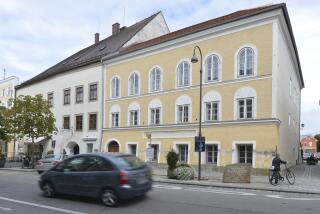Hitler’s Bunker Exposed for Last Time, Officials Say
- Share via
BERLIN — Construction workers have dug up the bunker where Adolf Hitler spent his final days, exposing the concrete site for a last time before it is paved over again with a new road in the heart of Berlin.
Despite calls from some to preserve the bunker--buried for decades beneath the Berlin Wall’s no man’s land--the city said Friday it sees no reason to maintain the “Fuehrerbunker,” where Hitler killed himself on April 30, 1945.
The exact spot of the bunker has been known since 1990. Peter Strieder, the city’s top development official, said “exposing these steel reinforcements raises no new arguments” for overturning a 1994 decision not to preserve the site.
Rusted metal rods protrude from a patch of concrete barely visible through a thin layer of dirt, but not much else can be seen of the 13-foot-tall structure. Workers dug into the roof of the bunker while trying to make sure no unexploded World War II bombs remained in the area.
The city said it plans to dig no deeper. Preparations for the new street will be completed in the coming weeks.
Since the collapse of the Berlin Wall in 1989 and the decision to return Germany’s government to the former Nazi seat of power, much of central Berlin has been turned into a construction site. The bunker lies next to a spot where several German states are building their offices in the capital.
As World War II wound to a close and the Soviet Red Army advanced into Berlin, Hitler retreated to the bunker--built deeper than others to allow him to survive stronger bomb blasts.
As he became more mentally unstable, Hitler spent his final days issuing orders to his defeated armies and dining on meals made by his vegetarian cook. The day before his suicide, he ordered his favorite Alsatian dog, Biondi, killed.
When the end came, Russian troops were just a block away. Hitler and his longtime mistress Eva Braun, whom he had married days earlier, killed themselves--Hitler with a shot through the mouth and Braun with poison.
Aides then dumped the bodies in a hole blasted open by a shell and partially incinerated them along with 14 other corpses.
Bodies Recovered by the Red Army
The shallow “grave” was hit repeatedly by Red Army shells and Soviet soldiers eventually dug up the remains--but what happened to them after that is in dispute. In 1993, Russia claimed to hold parts of Hitler’s skull in a state archive, but experts have disputed their authenticity.
After World War II, the Soviets, unable to destroy the heavily fortified bunkers, blasted their interior and filled them with sand. The East German army ripped out the main section in 1988 before apartment houses were built around the site.
The bunker is just the latest Nazi bomb shelter to be uncovered in the area, the former heart of the Nazi government and site of Hitler’s New Reich Chancellery.
In 1990, workers found the bunker rooms used by Hitler’s drivers just around the corner from Hitler’s bunker. Some Berliners argued for preserving that bunker, with its faded SS murals, as a historic site, but city officials decided to seal it up again, fearing it would attract neo-Nazis.
Last year, workers preparing another nearby site for Germany’s national Holocaust memorial uncovered a bunker believed to have been used by Nazi propaganda chief Joseph Goebbels. City officials said the memorial would be built over it on the football-field sized plot anyway.
Germany has also destroyed other sites connected to Hitler, such as a home in southern Germany, out of fears they could become shrines for neo-Nazis.
Still, some argue against destroying the relics of Germany’s past. The former head of the city’s archeological office said he favored preserving the bunkers to show that Germans aren’t afraid to confront the dark side of their history.
“These bunkers aren’t a secret anyway,” Alfred Kernd’l told the Der Tagesspiegel daily. “Every neo-Nazi knows to the meter exactly where they are.”
The city “likes to take away all bad and dirty traces,” said Dietmar Arnold, author of a book on Berlin’s tunnels and bunkers. “This is not the right way with history. . . . You can understand the history from this place only if you have everything together.”
But Andreas Nachama, a historian and head of Berlin’s Jewish community, said he doesn’t believe preserving every remnant from the Nazi era serves any purpose.
He praised the nearby “Topography of Terror” exhibit, which incorporates the basement of the former Gestapo headquarters and its torture cells into a well-researched documentation of Nazi crimes, as an example of the right way to deal with archeological finds.
“But it can’t be that whenever you find a piece of iron in the ground, you declare it a landmark,” he said.
Giese Kiesewetter, who lives in an apartment building near the bunker, was more concerned the new street would cut into her lawn and bring more traffic. But she also said there was no need to preserve the site.
“This is the past,” she said of the bunker. “One shouldn’t forget the past, but you don’t need to make something new out of it.”
More to Read
Sign up for Essential California
The most important California stories and recommendations in your inbox every morning.
You may occasionally receive promotional content from the Los Angeles Times.













